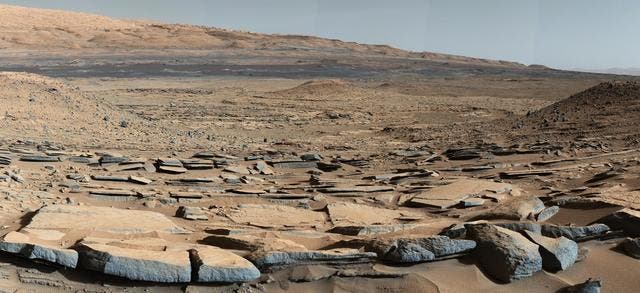Some outside-the-box thinking allowed NASA to calculate the density of Mount Sharp on Mars — and the results aren’t at all what they expected.

Image credits NASA / JPL-Caltech.
Curiosity has been on a lonely trek on the surface of Mars for almost a decade now. It landed there in 2012 and has been exploring the planet ever since. But its journey is teaching us a lot about our galactic neighbor, including the surprising porosity of its rocks.
Mount Sharp, Mount Porous
“What we were able to do is measure the bulk density of the material in Gale Crater,” says Travis Gabriel, a graduate student at the Arizona State University School of Earth and Space Exploration, who computed the densities of the rocks Curiosity has been driving over.
I really like this study. For starters, Curiosity wasn’t ‘meant’ to be able to measure the densities of huge bodies of rock when it was designed — at least, not in the way the team did it.
First off, some context: Curiosity can be used to estimate rock density, but this is based on chemical analysis of rocks it can actually bore through (so it’s limited to making surface measurements). Gale Crater (wherein Mount Sharp, officially “Aeolis Mons”, nestles) definitely qualifies as a ‘huge body of rock’ with its 96-mile (154 km) diameter, and its depths are definitely out of Curiosity’s reach.
To estimate densities, the rover will essentially dig into a rock, take out the residue, and analyze its mineralogical composition. Based on the particular species identified and their ratios, ground control can then estimate how dense said rock is. And NASA was content with this for the longest time. But the present study casts doubt on those previous estimates.
Working from the rocks’ mineral abundances as determined by the Chemistry and Mineralogy instrument, we estimated a grain density of 2810 kilograms per cubic meter,” Gabriel says. “However the bulk density that came out of our study is a lot less — 1680 kilograms per cubic meter.”
What the team did instead was to use Curiosity’s accelerometers and gyroscopes to read densities. These devices are pretty much exactly like that in any smartphone (only more accurate and expensive), and are used to determine Curiosity’s orientation and its motions. NASA uses readings from these devices to steer Curiosity across the face of Mars, just like you’d use those in your smartphone to steer towards the nearest pub.
These devices work round-the-clock, however — not just when you’re on the move. And those on Curiosity are sensitive enough to pick up on the local gravitational tug at whichever spot it finds itself on.
The team took engineering data beamed back by Curiosity ever since 2012, when it touched down on Mars. These readings were crunched to produce measurements of gravitational forces in more than 700 points across the rover’s track. The readings revealed that as Curiosity began ascending Mount Sharp, it started experiencing higher gravitational pulls. Which was expected.
But the increase was far weaker than what we’d expect to see in such a case, the authors report.
“The lower levels of Mount Sharp are surprisingly porous,” says lead author Kevin Lewis of Johns Hopkins University.
“We know the bottom layers of the mountain were buried over time. That compacts them, making them denser. But this finding suggests they weren’t buried by as much material as we thought.”
The findings help flesh out our understanding of how Mount Sharp came to be. Martian craters the size of Gale have central peaks raised by the very impact that scooped out the crater (Gale’s is Mount Sharp). So we know why Sharp is so tall. Its top layers also seem to be made out of wind-swept sediments, which are more easily eroded than rock. The prevailing theory up to now was that these sediments pressed down on the Mount and crater, compressing them into hardier rock, before eventually being swept away by the wind.
But the new findings suggest Mount Sharp’s lower layers have been compacted by only a half-mile to a mile (1 to 2 kilometers) of material — much less than if the crater had been completely filled.
“There are still many questions about how Mount Sharp developed, but this paper adds an important piece to the puzzle,” said Ashwin Vasavada, Curiosity’s project scientist at NASA’s Jet Propulsion Laboratory in Pasadena, California, which manages the mission.
“I’m thrilled that creative scientists and engineers are still finding innovative ways to make new scientific discoveries with the rover.”
This is definitely an interesting find — one that points to even more secrets yet to be unlocked on the slopes of Mount Sharp. The study also produced a powerful technique that NASA can use with Curiosity and future rovers to investigate far-off worlds. In essence, it’s pretty much the same principle as that used in gravimetry, but I definitely like seeing how much creativity the team brought to this study.
The paper “A surface gravity traverse on Mars indicates low bedrock density at Gale crater” has been published in the journal Science.


